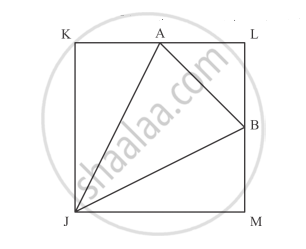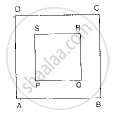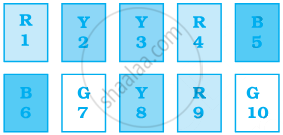Advertisements
Advertisements
प्रश्न
A die is thrown once. Find the probability of getting a number which (i) is a prime number (ii) lies between 2 and 6.
उत्तर
Total possible outcomes that occur after throwing a die once are 1,2,3,4,5,6
Number of possible outcomes = 6
(a) We need to find the probability of getting a prime number
Prime number is a number not divisible by any number except itself
Prime numbers on dice are 2,3 and 5.
Number of favourable outcomes =3
Probability of getting a prime number = `"Number of favourable outcomes"/"Total number of possible outcomes"`
Probability of getting a prime number=`3/6 = 1/2`
Therefore, probability of getting a prime number is `1/2`
(b) Probability of getting a number lying between 2 and 6
Number lying between 2 and 6 on a dice are 3,4 and 5.
Probability of getting a number lying between 2 and 6 =`3/6 = 1/2`
Therefore, Probability of getting a number lying between 2 and 6 is = `1/2`
संबंधित प्रश्न
In the Fig. below, JKLM is a square with sides of length 6 units. Points A and B are the
mid- points of sides KL and LM respectively. If a point is selected at random from the
interior of the square. What is the probability that the point will be chosen from the interior of ΔJAB?

In the given figure, a square dart board is shown. The length of a side of the larger square is 1.5 times the length of a side of the smaller square. If a dart is thrown and lands on the larger square. What is the probability that it will land in the interior of the smaller square?

The faces of a die bear numbers 0, 1, 2, 3, 4, 5. If the die is rolled twice, then find the probability that the product of digits on the upper face is zero.
A card is drawn from a well-shuffled deck of 52 playing cards. The probability that the card will not be an ace is
A bag contains 5 white and 7 red balls. One ball is drawn at random. What is the probability that ball drawn is not black?
A box contains 5 red marbles, 8 white marbles, and 4 green marbles, One marble is taken out of the box at random. What is the probability that the marble taken out will be red?
A piggy bank contains hundred 50 paise coins, fifity ₹1 coins, twenty ₹2 coins and ten ₹5 coins. If it is equally likely that one of the coins will fall out when the bank is turned upside down, find the probability that the coin which fell will be a ₹1 or ₹2 coin
A dice is rolled twice. Find the probability that 5 will not come up either time
Suppose you drop a tie at random on the rectangular region shown in the given figure. What is the probability that it will land inside the circle with diameter 1 m?

The probability of guessing the correct answer to a certain test questions is\[\frac{x}{12}\] If the probability of not guessing the correct answer to this question is\[\frac{ 2}{3}\] then x =
If P(E) = 0.05, then P(not E) =
A game of chance consists of spinning an arrow, which comes to rest pointing at one of the numbers 1, 2, 3, 4, 5, 6, 7, 8 and these are equally likely outcomes. Find the probability that the arrow will point at any factor of 8.
A bag contains 4 white balls, 5 red balls, 2 black balls and 4 green balls. A ball is drawn at random from the bag. Find the probability that it is neither red nor green.
A die is thrown, find the probability of getting:
a number greater than 4
Which of the following can not be the probability of an event?
(i)`2/7`
(ii)3.8
(iii) 37%
(iv) -0.8
(v) 0.8
(vi) `(-2)/5`
(vii) `7/8`
Three identical coins are tossed together. What is the probability of obtaining:
no head?
Two coins are tossed together. What is the probability of getting:
(i) at least one head
(ii) both heads or both tails.
In a family having three children, there may be no girl, one girl, two girls or three girls. So, the probability of each is `1/4`. Is this correct? Justify your answer
In a throw of a dice, the probability of getting an even number is the same as that of getting an odd number.
Sonia picks up a card from the given cards.

Calculate the probability of getting a Y card
